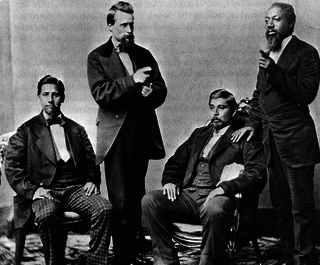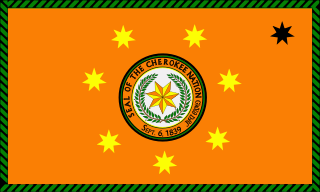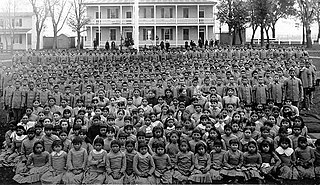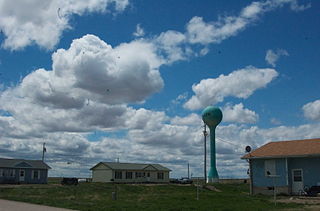
Native Americans, sometimes called American Indians, First Americans, or Indigenous Americans, are the Indigenous peoples of the United States or portions thereof, such as American Indians from the contiguous United States and Alaska Natives. The United States Census Bureau defines Native American as "all people indigenous to the United States and its territories, including Native Hawaiian and Other Pacific Islanders, whose data are published separately from American Indians and Alaska Natives". The U.S. census tracks data from American Indians and Alaska Native separately from Native Hawaiian and Other Pacific Islanders, who include Samoan Americans and Chamorros.

The Hopi are Native Americans who primarily live in northeastern Arizona. The majority are enrolled in the Hopi Tribe of Arizona and live on the Hopi Reservation in northeastern Arizona; however, some Hopi people are enrolled in the Colorado River Indian Tribes of the Colorado River Indian Reservation at the border of Arizona and California.

The Navajo Nation, also known as Navajoland, is a Native American reservation of Navajo people in the United States. It occupies portions of northeastern Arizona, northwestern New Mexico, and southeastern Utah. The seat of government is located in Window Rock, Arizona.

Tribal sovereignty in the United States is the concept of the inherent authority of Indigenous tribes to govern themselves within the borders of the United States.

An American Indian reservation is an area of land held and governed by a U.S. federal government-recognized Native American tribal nation, whose government is sovereign, subject to regulations passed by the United States Congress and administered by the United States Bureau of Indian Affairs, and not to the U.S. state government in which it is located. Some of the country's 574 federally recognized tribes govern more than one of the 326 Indian reservations in the United States, while some share reservations, and others have no reservation at all. Historical piecemeal land allocations under the Dawes Act facilitated sales to non–Native Americans, resulting in some reservations becoming severely fragmented, with pieces of tribal and privately held land being treated as separate enclaves. This jumble of private and public real estate creates significant administrative, political, and legal difficulties.
The Eastern Band of Cherokee Indians (EBCI), is a federally recognized Indian tribe based in western North Carolina in the United States. They are descended from the small group of 800–1,000 Cherokee who remained in the Eastern United States after the U.S. military, under the Indian Removal Act, moved the other 15,000 Cherokee to west of the Mississippi River in the late 1830s, to Indian Territory. Those Cherokee remaining in the east were to give up tribal Cherokee citizenship and to assimilate. They became U.S. citizens.

Blood quantum laws or Indian blood laws are laws in the United States that define Native American status by fractions of Native American ancestry. These laws were enacted by the federal government and state governments as a way to establish legally defined racial population groups. By contrast, many tribes do not include blood quantum as part of their own enrollment criteria.

The Cherokee Nation, also known as the Cherokee Nation of Oklahoma, is the largest of three Cherokee federally recognized tribes in the United States. It includes people descended from members of the Old Cherokee Nation who relocated, due to increasing pressure, from the Southeast to Indian Territory and Cherokee who were forced to relocate on the Trail of Tears. The tribe also includes descendants of Cherokee Freedmen, Absentee Shawnee, and Natchez Nation. As of 2023, over 450,000 people were enrolled in the Cherokee Nation.

A series of efforts were made by the United States to assimilate Native Americans into mainstream European–American culture between the years of 1790 and 1920. George Washington and Henry Knox were first to propose, in the American context, the cultural assimilation of Native Americans. They formulated a policy to encourage the so-called "civilizing process". With increased waves of immigration from Europe, there was growing public support for education to encourage a standard set of cultural values and practices to be held in common by the majority of citizens. Education was viewed as the primary method in the acculturation process for minorities.

Reservations in the United States, known as Indian reservations, are sovereign Native American territories that are managed by a tribal government in cooperation with the federal Bureau of Indian Affairs, a branch of the Department of the Interior, located in Washington, DC. There are 334 reservations in the United States today. As of 2008, almost a third of Native Americans in the United States live on reservations, totaling approximately 700,000 individuals. About half of all Native Americans living on reservations are concentrated on the ten largest reservations.

In the United States, tribal colleges and universities (TCUs) are a category of higher education, minority-serving institutions defined in the Higher Education Act of 1965. Each qualifies for funding under the Tribally Controlled Colleges and Universities Assistance Act of 1978 or the Navajo Community College Act ; or is cited in section 532 of the Equity in Educational Land-Grant Status Act of 1994.
The Harvard Project on American Indian Economic Development, also known as the Harvard Project, was founded in 1987 at Harvard Kennedy School at Harvard University. It administers tribal awards programs as well as provides support for students and conducting research. The Harvard Project aims to understand and foster the conditions under which sustained, self-determined social and economic development is achieved among American Indian nations through applied research and service.

Cherokee Preservation Foundation is an independent nonprofit foundation established in 2000 as part of the Tribal-State Compact amendment between the Eastern Band of Cherokee Indians (EBCI) and the State of North Carolina. The Foundation is funded by the EBCI from gaming revenues generated by the Tribe; it is not associated with any for-profit gaming entity and is a separately functioning organization independent of the Tribal government. It works to improve the quality of life of the EBCI and strengthen the western North Carolina region by balancing Cherokee ways with the pursuit of new opportunities.

The Native American Languages Act of 1990 (NALA) is a US statute that gives historical importance as repudiating past policies of eradicating indigenous languages of the Americas by declaring as policy that Native Americans were entitled to use their own languages. The fundamental basis of the policy's declaration was that the United States "declares to preserve, protect and promote the rights and freedom of Native Americans to use practice and develop Native American Languages".

Native American reservation inequality underlies a range of societal issues that affect the lives of Native American populations residing on reservations in the United States. About one third of the Native American population, about 700,000 people, lives on an Indian Reservation in the United States. Reservation poverty and other discriminatory factors have led to persisting social inequality on Native American reservations. Disparities between many aspects of life at the national level and at the reservation level, such as quality of education, quality of healthcare, substance use disorders, teenage pregnancy, violence, and suicide rates are significant in demonstrating the inequality of opportunities and situations between reservations and the rest of the country.
Contemporary Native American issues in the United States are topics arising in the late 20th century and early 21st century which affect Native Americans in the United States. Many issues stem from the subjugation of Native Americans in society, including societal discrimination, racism, cultural appropriation through sports mascots, and depictions in art. Native Americans have also been subject to substantial historical and intergenerational trauma that have resulted in significant public health issues like alcohol use disorder and risk of suicide.

The United States public policy agenda on issues affecting Native Americans under the Obama administration includes the signing of the Tribal Law and Order Act of 2010, which allowed tribal courts to extend and expand sentences handed down to them in criminal cases, strengthening tribal autonomy. Obama also supported and enforced the Executive Order 13175, which requires the federal government to consult with tribal governments when deliberating over policies and programs that would affect tribal communities. Under the Obama Administration was also the launching of Michelle Obama's program Let's Move In Indian Country, which aims to improve opportunities for physical activity, to increase access to healthy food in tribal communities, and to create collaborations between private and public sectors to build programs that will end childhood obesity in Native communities. Obama also supported tribal communities through certain provisions of the American Recovery and Reinvestment Act of 2009, which allocated $510 million for rehabilitation of Native American housing, and the settlement of the Keepseagle case, a lawsuit against the United States Department of Agriculture for discriminating against tribal communities by not allowing them equal access to the USDA Farm Loan Program. Most recently, Obama signed Executive Order 13592, which seeks to improve educational opportunities for American Indian and Alaska Natives. Obama has been praised by many tribal leaders, including those who claim he has done more for Native Americans than all of his predecessors combined.

The Cherokee Immersion School is a Cherokee language immersion school in Park Hill, Oklahoma, with a Tahlequah post office address. It is for children during pre-school to grade 8.

The impact of the COVID-19 pandemic on Native American tribes and tribal communities has been severe and has emphasized underlying inequalities in Native American communities compared to the majority of the American population. The pandemic exacerbated existing healthcare and other economic and social disparities between Native Americans and other racial and ethnic groups in the United States. Along with black Americans, Latinos, and Pacific Islanders, the death rate in Native Americans due to COVID-19 was twice that of white and Asian Americans, with Native Americans having the highest mortality rate of all racial and ethnic groups nationwide. As of January 5, 2021, the mortality impact in Native American populations from COVID-19 was 1 in 595 or 168.4 deaths in 100,000, compared to 1 in 1,030 for white Americans and 1 in 1,670 for Asian Americans. Prior to the pandemic, Native Americans were already at a higher risk for infectious disease and mortality than any other group in the United States.















